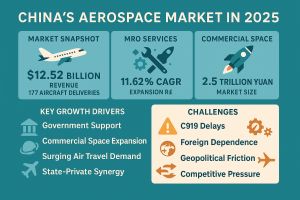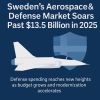China’s commercial aerospace industry is entering a critical phase in 2025—marked by rapid expansion, government-backed innovation, and ambitious domestic programs. Yet, the sector also faces mounting pressure from geopolitical tensions, global competition, and technological dependencies.
Market Snapshot: Strong Growth Across Segments
Commercial Aircraft: Revenue is projected to reach $12.52 billion in 2025, supported by 177 aircraft deliveries.
Commercial Space: The market is expected to surpass 2.5 trillion yuan, as Beijing promotes the “safe and healthy development” of private and state-owned ventures.
MRO Services: The aerospace maintenance, repair, and overhaul (MRO) market is set for sustained growth, with a CAGR of 11.62% (2025–2035), driven by expanding and aging fleets.
Key Growth Drivers
Government Support: Policies like Made in China 2025 and the inclusion of “commercial space” in national plans reinforce state investment and localized manufacturing, pushing foreign suppliers to adapt to domestic sourcing rules.
Commercial Space Expansion: China’s private and state enterprises are achieving milestones in reusable rocketsand commercial satellite launches, building a complete, self-reliant ecosystem.
Surging Air Travel Demand: Despite slower GDP growth, China is on track to become the world’s largest air travel market by 2043, sustaining demand for new aircraft and MRO capacity.
State-Private Synergy: The “dual-engine model”—state-owned firms providing scale and private firms driving innovation—remains a core strength of China’s aerospace strategy.
Challenges: Supply Chains, Certification, and Competition
C919 Delays: COMAC’s C919 jet continues to face production bottlenecks, supply chain disruptions, and a lack of international certification—limiting access to Western markets until at least 2028.
Foreign Dependence: Heavy reliance on Western components, especially engines, exposes production to export controls and trade restrictions.
Geopolitical Friction: Ongoing U.S.–China tensions—including export bans and tariffs—have complicated supply chains and raised production costs.
Competitive Pressure: Airbus and Boeing remain dominant, with Airbus expanding local operations in Tianjin. Meanwhile, China’s push for self-sufficiency adds complexity for foreign suppliers navigating IP and compliance risks.
Outlook: Ambitious but Tested
China’s aerospace sector is growing on two powerful fronts—commercial aviation and space—supported by policy, investment, and a massive domestic market. The C919’s progress remains a bellwether of China’s technological independence, while commercial space ventures reflect its ambition to become a global leader in next-generation aerospace innovation.
However, success will hinge on balancing self-reliance and global collaboration, managing supply chain resilience, and achieving regulatory milestones. If China can overcome these challenges, 2025 could mark the beginning of its transition from fast follower to formidable aerospace powerhouse.





